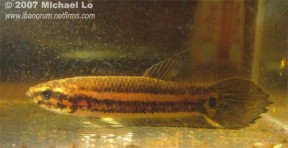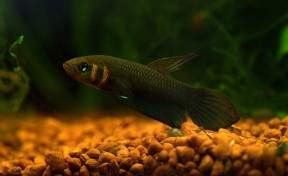Betta mandor
Etymology
mandor: named for the type locality which is located close to Mandor, West Kalimantan province, Indonesia.
Classification
Order: Perciformes Family: Osphronemidae
Distribution
At time of writing it’s only been collected close to the villages of Mandor and Anjungan in the lower Kapuas River basin, West Kalimantan (Kalimantan Barat), Borneo, Indonesia.
Fish from the two localities are often labelled as such by collectors and enthusiasts in order to maintain accuracy and preserve pure bloodlines.
Both areas have been extensively disturbed by illegal logging activity in recent years and the fish may be under threat.
Habitat
Typically inhabits forest swamp streams and pools, some of which have been measured at just a few centimetres deep.
These are usually shaded from the sun, the dense canopy of branches above meaning very little light penetrates the water surface and marginal vegetation also tends to grow thickly.
The water itself is often stained with humic acids and other chemicals released by decaying organic material.
The dissolved mineral content is negligible, pH quite low and substrate composed mainly of fallen leaves, branches and submerged tree roots.
Maximum Standard Length
50 – 60 mm.
Aquarium SizeTop ↑
An aquarium with base measurements of 60 ∗ 30 cm or equivalent is sufficient for a single pair, with something larger required for a group.
Maintenance
Can be maintained in a fully-decorated aquarium although many breeders prefer not to use a substrate for ease of maintenance.
Driftwood roots and branches can be used and placed such a way that a few shady spots are formed, and clay plant pots or lengths of piping can also be included to provide further shelter.
The addition of dried leaf litter offers additional cover for the fish and brings with it the growth of microbe colonies as decomposition occurs.
These can provide a valuable secondary food source for fry and the tannins and other chemicals released by the decaying leaves are also considered beneficial for fishes from blackwater environments. Alder cones may also be used for the latter purpose.
There is no need to use natural peat, the collection of which is both unsustainable and environmentally-destructive.
Fairly dim lighting is preferable and you can add aquatic plant species able to survive under such conditions such as Microsorum, Taxiphyllum or Cryptocoryne spp., while floating vegetation, especially Ceratopteris spp., is also useful.
Filtration need not be too strong, with an air-powered sponge filter set to turn over gently adequate.
Keep the tank well-covered and do not fill it to the top as like all Betta spp. it requires occasional access to the layer of humid air that will form above the water surface, and is an excellent jumper.
This species requires acidic conditions with negligible carbonate hardness and very low general hardness so a reverse osmosis unit or other method of obtaining soft water may need to be employed, and this can be further acidified using phosphoric acid or similar if necessary.
It’s also sensitive to fluctuating organic wastes and should never be introduced to biologically-immature aquaria.
Water Conditions
Temperature: 22 – 27 °C
pH: At Mandor the pH values range between 4.8 – 5.5, but in the aquarium a range of 4.0 – 6.5 has proven acceptable.
Hardness: 18 – 90 ppm
Diet
Likely to prey on insects plus other small invertebrates and zooplankton in nature.
Captive fish will normally accept dried products once they’re recognised as edible but should be offered plenty of small live or frozen foods such as Daphnia, Artemia, bloodworm, etc.
Small insects such as crickets or Drosophila fruit flies are also suitable to use; it’s best to fill the stomachs of these by feeding them fish flakes or some kind of vegetable matter before offering them to the fish.
Take care not to overfeed as Betta spp. seem particularly prone to obesity.
Behaviour and CompatibilityTop ↑
Not recommended for the standard community set-up for reasons already touched upon.
It’s care requirements and disposition mean it’s best kept alone or with very peaceful species since much bigger or more vigorous fishes are likely to intimidate and outcompete it.
Some small cyprinids and loaches that inhabit similar environments in nature are compatible, but the presence of any other fishes may prove a distraction should a pair decide to spawn.
Mixed reports exist as to whether it can be maintained in multiple pairs or harem-type groups comprising a single male alongside several females.
Some state report that although some chasing and squabbling over territory occurs actual physical damage is rare, while others recommend keeping it in single pairs having observed sustained aggression towards conspecifics from the dominant individuals in a group.
Sexual Dimorphism
Males are more colourful and develop more-extended unpaired fins than females.
The opercular bars present in both sexes are usually orange to reddish and more well-defined in males, golden to yellow in females.
Reproduction
Paternal mouthbrooder. Ideally organise a separate tank for breeding purposes, unless the fish are already being maintained alone, setting this up as suggested above.
The tank should have the tightest-fitting cover you can find (some breeders use clingfilm instead to ensure no gaps) as the fry need access to a layer of warm, humid air without which development of the labyrinth organ can be impaired.
Following a protracted courtship, eggs and milt are released during an ’embrace’ typical of osphronemids in which the male wraps his body around that of the female.
Several ‘dummy’ embraces may be required before spawning commences.
However in contrast to the majority of mouthbrooding Betta spp. the eggs are not caught in the anal fin of the male but that of the female as in bubble-nesters.
The male then collects the eggs directly in his mouth and the cycle is repeated until the female is spent of eggs, a process which can take some time.
A brooding male may swallow or release the eggs prematurely if stressed or inexperienced, so it’s preferable to leave the female in situ.
The incubation period is 8-14 days at the end of which the male will begin to release fully-formed, free-swimming fry.
At this point they can be removed or left to grow alongside the parents, with some reports suggesting they actually grow more quickly under such circumstances.
The fry are large enough to accept motile foods such as microworm and Artemia nauplii immediately, though it should be noted that there exist reports of young Betta developing health issues if fed excessive amounts of the latter.
Offer small amounts of different foods 2 -3 times per day for optimal growth rate, and don’t change too much water at once, with regular, small changes preferable to intermittent larger ones.
NotesTop ↑
This species was known as B. sp. ‘Mandor’ or B. sp. ‘ninja’ prior to official description.
It belongs to the Betta foerschi group of closely-related species within the genus, of which members share the following set of characters: possession of iridescent blue or green unpaired fins; rays and interradial membranes in unpaired fins not contrasting; dorsal fin with thin, bright white distal band; opercle with two, reddish-yellow, vertical bars.
They are regarded as being closely-related to bubble-nesting Betta species since they share exhibit certain similarities in morphology, particularly in the structure of head and mouth, colour pattern, and reproductive strategy.
B. mandor can be diagnosed by the following combination of characters: twin vertical red bars on opercle in life; male with black body, female with brown body in life; 32-34 lateral scales; 25-28 anal-fin rays; 6½-8 subdorsal scales; body depth at dorsal-fin origin 21.2-24.2 % SL; interorbital distance 27.1-32.1 % HL.
B. mandor is sometimes traded as B. foerschii and these two can be difficult to tell apart.
They vary in the following characters: transverse scales 8.5 in B. foerschi vs. 9.5-10 in B. mandor; lateral scales 28.5-31 vs. 32-34; caudal-fin length127.2-133.5 % SL vs. 136.7-149.1; caudal peduncle 17.5-21.0 % SL vs. 15.9-18.3; body depth at dorsal–fin origin 24.4-28.9 % SL vs. 21.2-24.2; dorsal–fin base length 10.0-12.2 % SL vs. 12.3-16.7; interorbital distance 9.6-13.4 % SL vs. 8.4-9.5; snout length 7.3-8.0 % SL vs. 3.9-7.0.
The genus Betta is the most speciose within the family Osphronemidae with almost 70 recognised members and looks set to grow further with new ones continuing to be described on a regular basis since the turn of the century.
Member species have successfully adapted to inhabit a variety of ecological niches from stagnant ditches to flowing hill streams including some extreme environments such as highly acidic peat swamp forests.
The referral of members to a number of groups containing closely-related species is now generally accepted but largely based on morphological and behavioural characters.
Molecular phylogenetic work may therefore prove useful in more precisely determining relationships between these fishes.
A full list of the species groups as currently recognised can be found here.
Like others in the suborder Anabantoidei this species possesses an accessory breathing organ known as the labyrinth.
So-called due to its maze-like structure this organ allows the fish to breathe atmospheric air to a certain extent.
Comprising paired suprabranchial organs formed via expansion of the epibranchial (upper) section of the first gill arch and housed in a chamber above the gills, it contains many highly-vascularised, folded flaps of skin which function as a large respiratory surface.
Its structure varies in complexity between species, tending to be better-developed in those inhabiting harsher environments.
References
- Tan, H. H. and P. K. L. Ng, 2006 - Ichthyological Exploration of Freshwaters 17(2): 97-114
Six new species of fighting fish (Teleostei: Osphronemidae: Betta) from Borneo. - Schaller, D. and M. Kottelat, 1989 - Aquarien und Terrarien-Zeitschrift 43(1): 31, 33-37
Betta strohi sp. n., ein neuer Kampffisch aus Südborneo (Osteichthyes: Belontiidae). - Tan, H. H. and P. K. L. Ng, 2005 - Raffles Bulletin of Zoology Supplement (13): 43-99
The fighting fishes (Teleostei: Osphronemidae: Genus Betta) of Singapore, Malaysia and Brunei. - Vierke, J., 1979 - Aquarium Aqua Terra 13(123): 386-390
Betta anabatoides und Betta foerschi spec. nov., zwei Kampffische aus Borneo.











